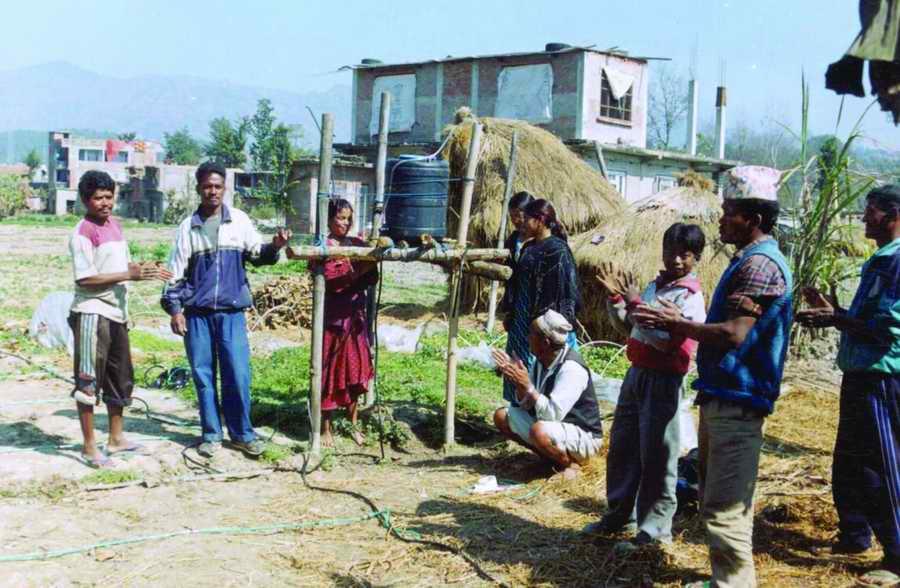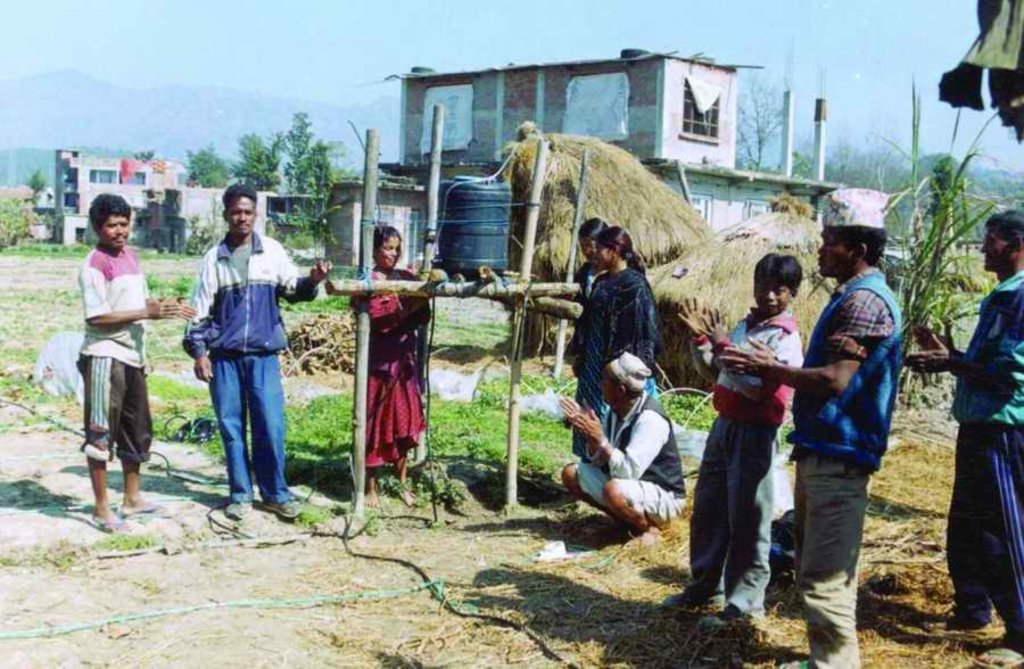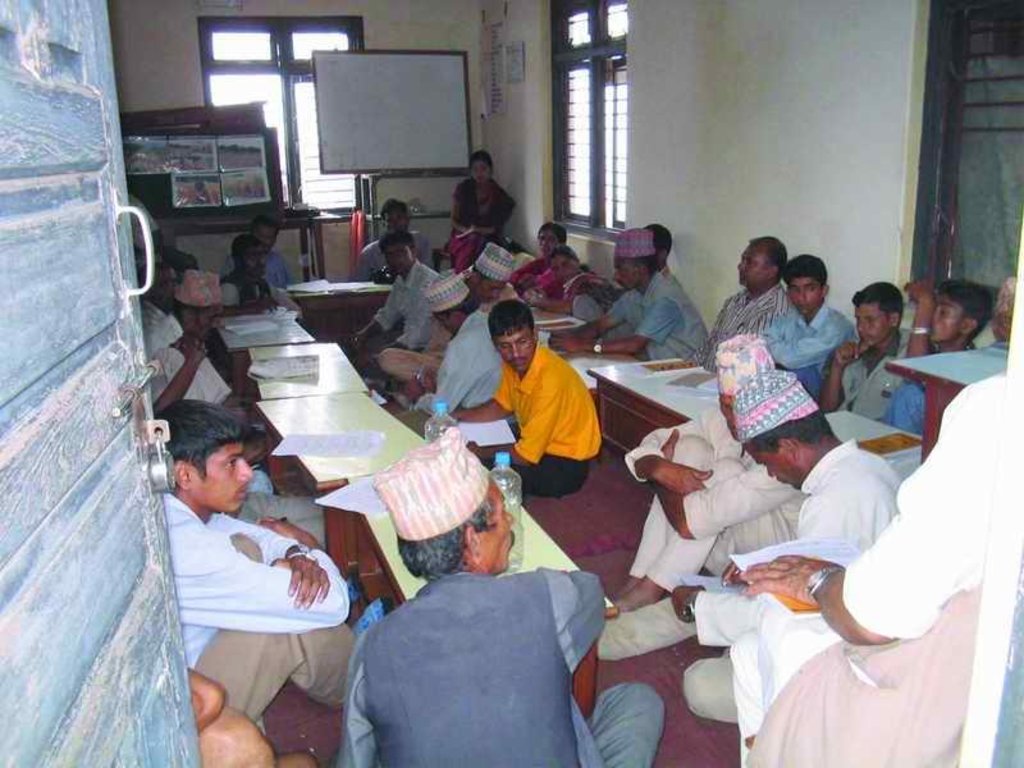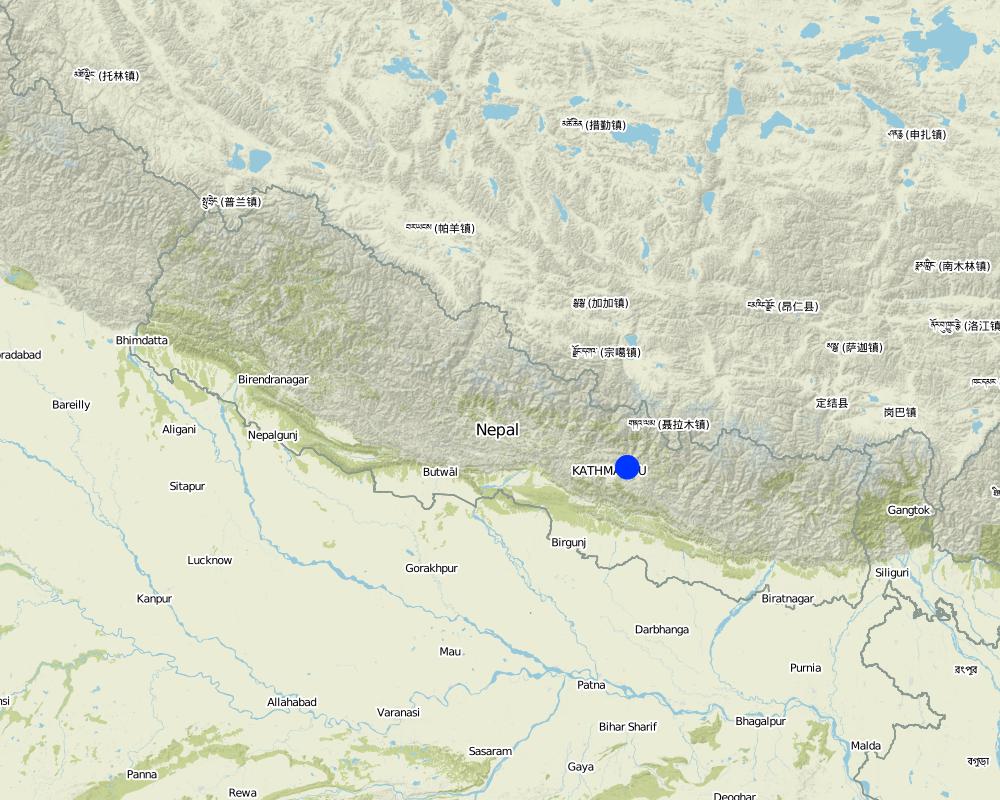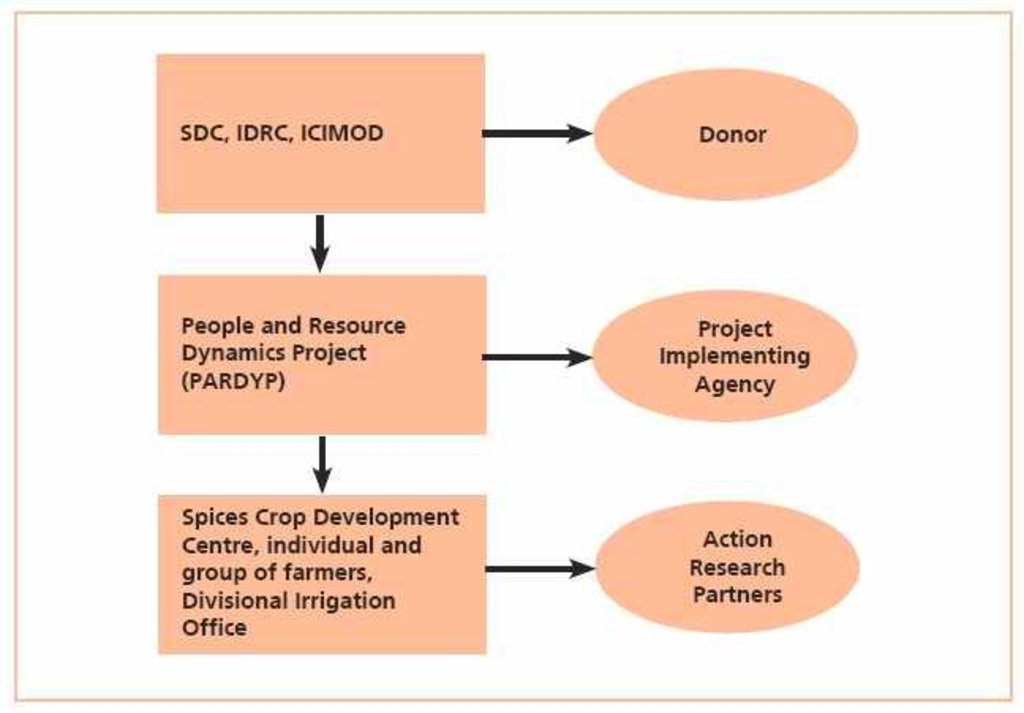Participatory action research on drip irrigation [เนปาล]
- ผู้สร้างสรรค์:
- การอัพเดท:
- ผู้รวบรวม: Madhav Dhakal
- ผู้เรียบเรียง: –
- ผู้ตรวจสอบ: Laura Ebneter
approaches_2350 - เนปาล
ดูส่วนย่อย
ขยายทั้งหมด ย่อทั้งหมด1. ข้อมูลทั่วไป
1.2 รายละเอียดที่ติดต่อได้ของผู้รวบรวมและองค์กรที่เกี่ยวข้องในการประเมินและการจัดเตรียมทำเอกสารของแนวทาง
ผู้เชี่ยวชาญ SLM:
ชื่อของโครงการซึ่งอำนวยความสะดวกในการทำเอกสารหรือการประเมินแนวทาง (ถ้าเกี่ยวข้อง)
CDE Centre for Development and Environment (CDE Centre for Development and Environment) - สวิตเซอร์แลนด์ชื่อของโครงการซึ่งอำนวยความสะดวกในการทำเอกสารหรือการประเมินแนวทาง (ถ้าเกี่ยวข้อง)
ICIMOD International Centre for Integrated Mountain Development (ICIMOD) - เนปาล1.3 เงื่อนไขที่เกี่ยวข้องกับการใช้ข้อมูลที่ได้บันทึกไว้ผ่านทาง WOCAT
ผู้รวบรวมและวิทยากรหลักยอมรับเงื่อนไขเกี่ยวกับการใช้ข้อมูลที่ถูกบันทึกผ่านทาง WOCAT:
ใช่
1.4 การอ้างอิงถึงแบบสอบถามเรื่องเทคโนโลยี SLM
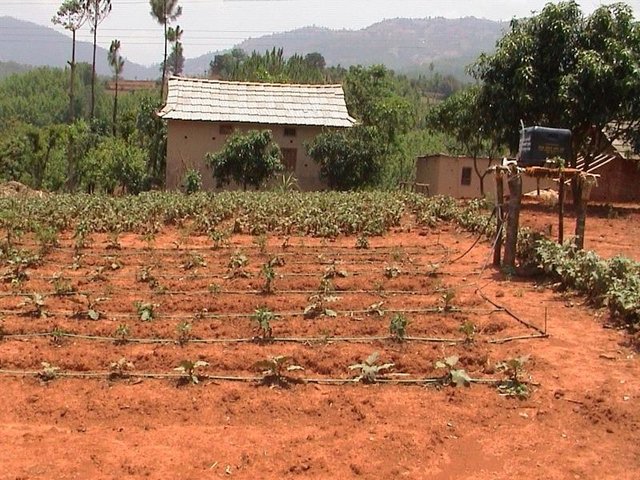
Low cost drip irrigation [เนปาล]
An irrigation system which allows the slow and precise delivery of water to crops
- ผู้รวบรวม: Madhav Dhakal
2. คำอธิบายของแนวทาง SLM
2.1 การอธิบายแบบสั้น ๆ ของแนวทาง
Conducting participatory action research with farmers and line agencies for demonstrating, disseminating and scaling up drip irrigation.
2.2 การอธิบายอย่างละเอียดของแนวทาง
การอธิบายอย่างละเอียดของแนวทาง:
Most farming in the uplands of Nepal's midhills is rainfed with many fi elds remaining fallow during the dry season due to lack of irrigation water. The People and Resource Dynamics Project (PARDYP) water demand and supply survey identified scarcity of irrigation water as a major issue in Nepal's midhills. To assess the potential of drip irrigation to address this problem, the University of British Columbia (UBC) in 2000/2001, in collaboration with PARDYP, tested a low cost irrigation drip set and a more costly set in the Jhikhu Khola watershed; and PARDYP and Tribhuvan University's Institute of Engineering (Nepal) tested the low cost set with farmers at another site at Kubinde village, Kavre.
PARDYP started research on drip irrigation at an agricultural research station (the Spices Crop Development Centre at Tamaghat, Kabhrepalanchok) and brought different stakeholders, principally farmers, to the station to learn. After seeing the trials some farmers, especially those living near the research station, started testing drip irrigation on their farms. From 2001 to 2004, PARDYP subsidised 50% of the cost of the drip sets to most adopting farmers. PARDYP organised several farm visits for stakeholders to the research station and farmers’ fi elds. The number of interested farmers increased and many started testing and demonstrating the technology on their farms. PARDYP provided technical support during installation, advice about water application, and trouble shooting training to user farmers. Soon, many farmers started using drip irrigation with little or no technical support from PARDYP. Some collected quantitative and qualitative information on the performance of their systems. Results and experiences were shared regularly after cropping seasons through interaction meetings. Users’ experiences convinced many others to adopt the technology.
Interaction meetings were organised to communicate farmers’ feedback to the organisation and businesses involved in making the drip sets. Farmers from the watershed were taken to the drip set manufacturers to establish a direct link between them and to allow the project to phase out its support.
This approach emphasised on-station to on-farm research and demonstration to facilitate ongoing monitoring and evaluation of the performance of locally made drip sets.
2.3 รูปภาพของแนวทาง
2.5 ประเทศ ภูมิภาค หรือสถานที่ตั้งที่ได้นำแนวทางไปใช้
ประเทศ:
เนปาล
ข้อมูลเฉพาะเพิ่มเติมของสถานที่ตั้ง:
Kavrepalanchowk/ Jhikhu Khola watershed
Map
×2.6 วันที่เริ่มต้นและสิ้นสุดของแนวทาง
การสิ้นสุดลง (ถ้าแนวทางไม่ได้ใช้อีกต่อไป):
2005
2.7 ประเภทของแนวทาง
- ใช้โครงงานหรือแผนงานเป็นฐาน
2.8 เป้าหมายหรือวัตถุประสงค์หลักของแนวทาง
The Approach focused mainly on SLM with other activities (income generating activities, vegetable farming with micro irrigation system)
To test, demonstrate, and evaluate drip irrigation systems under local conditions with multiple stakeholders. To share results and experiences with communities to scale up the technology
The SLM Approach addressed the following problems: - Lack of systematic on-farm research on drip irrigation. - Weak institutional collaboration for developing, disseminating and scaling up drip technology. - Inadequate water available for agriculture alongside strong seasonality and poor irrigation facilities
2.9 เงื่อนไขที่เอื้ออำนวยหรือเป็นอุปสรรคต่อการนำเทคโนโลยีภายใต้แนวทางนี้ไปปฏิบัติใช้
การมีไว้ให้หรือการเข้าถึงแหล่งการเงินและบริการ
- เป็นอุปสรรค
Insufficient government incentives
Treatment through the SLM Approach: A Cost-effective technology and implementing approach
การจัดตั้งระดับองค์กร
- เป็นอุปสรรค
Weak institutional collaboration among line agencies
Treatment through the SLM Approach: Participatory action research with several institutions - universities, local research centres, and farmers
กรอบแนวทางในการดำเนินการด้านกฎหมาย (การถือครองที่ดิน สิทธิในการใช้ที่ดินและน้ำ)
- เอื้ออำนวย
The existing land ownership, land use rights / water rights greatly helped the approach implementation: Because of private land owners there were no conflicts on land to implement the technology and for it's dissemination. and scaling up.
ความรู้เกี่ยวกับ SLM การเข้าถึงการสนับสนุนด้านเทคนิค
- เป็นอุปสรรค
Promotion of micro irrigation was not a priority of line agencies in the study area
Treatment through the SLM Approach: Technology implemented with multiple stakeholders' participation
อื่นๆ
- เป็นอุปสรรค
Lack of awareness on potential water-saving options
Treatment through the SLM Approach: Community-based training, discussions and field visits
3. การมีส่วนร่วมและบทบาทของผู้มีส่วนได้ส่วนเสียที่เกี่ยวข้อง
3.1 ผู้มีส่วนได้ส่วนเสียที่เกี่ยวข้องในแนวทางนี้และบทบาท
- ผู้ใช้ที่ดินระดับท้องถิ่นหรือชุมชนระดับท้องถิ่น
On farm research and demonstration
men and women worked equally
- องค์กรที่ขึ้นอยู่กับชุมชน
existing groups of land users; community forest user group and terrace improvement committee
- ผู้เชี่ยวชาญ SLM หรือที่ปรึกษาการเกษตร
Field technicians
- องค์กรพัฒนาเอกชน
On station research
- รัฐบาลแห่งชาติ (ผู้วางแผน ผู้ทำการตัดสินใจ)
On station research
- องค์การระหว่างประเทศ
On station research
3.2 การเกี่ยวข้องของผู้ใช้ที่ดินระดับท้องถิ่นหรือชุมชนระดับท้องถิ่นในช่วงต่างๆของแนวทาง
| ความเกี่ยวข้องของผู้ใช้ที่ดินระดับท้องถิ่นหรือชุมชนระดับท้องถิ่น | ระบุผู้ที่มีส่วนเกี่ยวข้องและอธิบายกิจกรรม | |
|---|---|---|
| การริเริ่มหรือการจูงใจ | ปฏิสัมพันธ์ | A water demand and supply survey identified problem of lack of water in the dry season for irrigating crops. The concept of drip irrigation was shared at public meetings and a demonstration plot established at a local agricultural research centre. Several farmer visits organised to the research cent |
| การวางแผน | ปฏิสัมพันธ์ | Public meetings; farmers showed interest in drip irrigation. The project supported them by transporting drip sets to the nearest roadhead and subsidising the purchase costs |
| การดำเนินการ | ระดมกำลังด้วยตนเอง | Farmers implemented the technology and the project provided technical support |
| การติดตามตรวจสอบหรือการประเมินผล | ปฏิสัมพันธ์ | Mainly: measurements/observations, public meetings; partly: reporting; Farmers monitored the technology with project support. Evaluation was usually done at meetings and exchange visits. |
| Research | ระดมกำลังด้วยตนเอง | On-farm; The technology was tested at the local research centre during the first few years followed by on-farm research with farmers. Farmers collected and analysed quantitative and qualitative information themselves. |
3.3 แผนผังแสดงขั้นตอนการทำงาน (ถ้ามี)
คำอธิบาย:
PARDYP project donors and implementing partners: SDC (Swiss Agency for Development and Cooperation); IDRC (International Development Research Centre); ICIMOD
3.4 การตัดสินใจเลือกใช้เทคโนโลยี SLM
ระบุผู้ที่ทำการตัดสินใจเลือกเทคโนโลยีมากกว่าหนึ่งวิธีไปปฏิบัติใช้:
- ผู้เชี่ยวชาญ SLM เป็นผู้ตัดสินใจหลัก ที่ติดตามให้คำปรึกษากับผู้ใช้ที่ดิน
การอธิบาย:
The project tested drip irrigation as a promising water-efficient technology.
Decisions on the method of implementing the SLM Technology were made by mainly by SLM specialists with consultation of land users. It was tested first in the research station to build confidence of the project staff and surrounding villagers, and was then taken to interested farmers' fields.
4. การสนับสนุนด้านเทคนิค การสร้างขีดความสามารถ และการจัดการด้านความรู้
4.1 การสร้างขีดความสามารถ / การอบรม
ได้มีการจัดอบรมให้แก่ผู้ใช้ที่ดินหรือผู้มีส่วนได้ส่วนเสียคนอื่น ๆ หรือไม่:
ใช่
ให้ระบุว่าใครเป็นผู้ได้รับการอบรม:
- ผู้ใช้ที่ดิน
- extensionists/trainers
รูปแบบการอบรม:
- เกษตรกรกับเกษตรกร
- ใช้พื้นที่ทำการสาธิต
- จัดการประชุมสู่สาธารณชน
หัวข้อที่พูด:
Training programmes were organised on how to install and maintain the drip systems. Likewise farmers were trained on record keeping for water application, production, and cost-benefit analysis.
4.2 การบริการให้คำแนะนำ
ผู้ใช้ที่ดินมีการเข้าถึงการรับบริการให้คำปรึกษาหรือไม่:
ใช่
การอธิบาย/แสดงความคิดเห็น:
Name of method used for advisory service: Farmer to farmer dissemination; Key elements: Interactive meeting, on-station and on-farm visits, workshops; 1) Mainly: projects own extension structure and agents, Partly: non-governmental agency; Extension staff: specifically hired project employees 2) Target groups for extension: land users, technicians/SLM specialists; Activities: interactive meeting, farm visits , workshops
Advisory service is quite adequate to ensure the continuation of land conservation activities; Government , NGOs and CBOs still continuing the activities.
4.3 การเสริมความแข็งแกร่งให้กับสถาบัน (การพัฒนาองค์กร)
สถาบันได้รับการจัดตั้งขึ้นมาหรือเสริมความแข็งแกร่งโดยแนวทางนี้หรือไม่:
- ใช่ อย่างมาก
ระบุระดับของสถาบันที่ได้รับการเสริมความแข็งแกร่งหรือจัดตั้งขึ้นมา:
- ท้องถิ่น
ระบุประเภทของการให้ความช่วยเหลือสนับสนุน:
- การสร้างขีดความสามารถ / การอบรม
ให้รายละเอียดเพิ่มเติม :
On-site training during drip installation provided to a local NGO (Ranipani Gram Sewa Kendra) with vegetable seedling support.
4.4 การติดตามตรวจสอบและประเมินผล
การติดตามตรวจสอบและประเมินผลเป็นส่วนหนึ่งของแนวทางหรือไม่:
ใช่
ความคิดเห็น:
bio-physical aspects were ad hoc monitored through observations; indicators: land use change, crop rotation, soil surveys
technical aspects were regular monitored through measurements; indicators: water requirements
socio-cultural aspects were ad hoc monitored through observations; indicators: socioeconomic surveys
economic / production aspects were ad hoc monitored through measurements; indicators: cost-benefit production
area treated aspects were regular monitored through measurements; indicators: area under drip irrigation
land users involved aspects were regular monitored through observations; indicators: number of drip users
There were few changes in the Approach as a result of monitoring and evaluation: The subsidy system was withdrawn and work with groups rather than single households was started. In addition, interaction programmes were organised at different locations in the watershed.
There were no changes in the Technology as a result of monitoring and evaluation.
4.5 การวิจัย
การวิจัยเป็นส่วนหนึ่งของแนวทางหรือไม่:
ใช่
ให้ข้อมูลเพิ่มเติมและให้ระบุผู้ทำการวิจัย:
Action research was carried out to compare the water requirements, the cost-benefit, and the advantages and disadvantages of traditional and drip irrigation.
Research was carried out both on station and on-farm
5. การสนับสนุนด้านการเงินและวัสดุอุปกรณ์
5.1 ระบุงบประมาณประจำปีสำหรับแนวทาง SLM นี้
ถ้าหากว่างบประมาณประจำปีไม่เป็นที่ทราบแน่นอน ให้ระบุช่วงลงไป:
- 2,000-10,000
แสดงความคิดเห็น (แหล่งของการระดมทุน ผู้บริจาคคนสำคัญ):
Approach costs were met by the following donors: international non-government (SDC, IDRC, ICIMOD): 50.0%; local community / land user(s) (labour): 50.0%
5.2 การสนับสนุนด้านการเงิน / วัสดุอุปกรณ์ให้แก่ผู้ใช้ที่ดิน
ผู้ใช้ที่ดินได้รับการสนับสนุนด้านการเงิน / วัสดุอุปกรณ์ไปปฏิบัติใช้เทคโนโลยีหรือไม่:
ใช่
5.3 เงินสนับสนุนสำหรับปัจจัยนำเข้า (รวมถึงแรงงาน)
- อุปกรณ์
| ระบุปัจจัยนำเข้าที่ได้รับการสนับสนุน | เห็นด้วยระดับไหน | ระบุเงินสนับสนุน |
|---|---|---|
| เครื่องจักร | ||
ถ้าแรงงานโดยผู้ใช้ที่ดินเป็นปัจจัยนำเข้าที่มีอยู่มากมาย ระบุด้วยว่าเนื่องจาก:
- สมัครใจ
ความคิดเห็น:
Fifty percent subsidy on drip was provided by the project during initial stages (first two years) to a limited farmers.
5.4 เครดิต
มีการจัดหาเครดิตมาให้ภายใต้แนวทาง SLM หรือไม่:
ไม่ใช่
6. การวิเคราะห์ผลกระทบและการสรุป
6.1 ผลกระทบของแนวทาง
ช่วยให้ผู้ใช้ที่ดินนำเอาเทคโนโลยี SLMไปใช้และบำรุงรักษาสภาพไว้ได้หรือไม่:
- ไม่ใช่
- ใช่ เล็กน้อย
- ใช่ ปานกลาง
- ใช่ อย่างมาก
Land users started cropping land that was previously left fallow in the dry season and increased the area under cash crops - especially vegetables. Drip irrigation used only 60% of water compared to bucket irrigation.
Na Na
Did other land users / projects adopt the Approach?
- ไม่ใช่
- ใช่ เล็กน้อย
- ใช่ ปานกลาง
- ใช่ อย่างมาก
A few institutions and district level line agencies like Ranipani Gram Sewa Kendra, a local NGO, and the Divisional Irrigation Office Kabhrepalanchok started organising interactive meetings to discuss drip irrigation.
6.2 แรงจูงใจหลักของผู้ใช้ที่ดินเพื่อที่จะนำ SLM ไปปฏิบัติใช้
- การผลิตที่เพิ่มขึ้น
increased vegetable production
- ภาระงานลดลง
less time required for irrgation, fertigation
6.3 ความยั่งยืนของกิจกรรมของแนวทาง
ผู้ใช้ที่ดินสามารถทำให้สิ่งต่างๆ ที่ได้ปฏิบัติใช้โดยแนวทางนี้ยั่งยืนได้หรือไม่ (โดยไม่มีการสนับสนุนจากภายนอก):
- ใช่
ถ้าตอบว่าใช่ ให้อธิบายว่าอย่างไร :
Most of the land users continue to use drip irrigation and are maintaining the sets. A few farmers, including women, abandoned drip after using it for some time. The women who abandoned it said they did so because of 'lack of technical knowledge', 'not enough labour' and 'too far to get water'
6.4 จุดแข็งและข้อได้เปรียบของแนวทาง
| จุดแข็ง / ข้อได้เปรียบของแนวทางในทัศนคติของผู้ใช้ที่ดิน |
|---|
| Regular interaction meetings provided land users with a platform to share ideas and for non-adopters to learn about drip from users. (How to sustain/ enhance this strength: Continue such meetings and involve more potential adopters) |
| Farmer-to-farmer visits were helpful to build confi dence of farmers by seeing on-site results (How to sustain/ enhance this strength: Continue such meetings and involve more potential adopters) |
| On-site training on drip installation and maintenance helped build confi dence in using drip sets (How to sustain/ enhance this strength: Continue such meetings and involve more potential adopters) |
| จุดแข็ง / ข้อได้เปรียบของแนวทางในทัศนคติของผู้รวบรวมหรือวิทยากรหลัก |
|---|
| This approach emphasises the participation of multiple stakeholders in researching, disseminating, and scaling up the use of the technology. (How to sustain/ enhance this strength: Identify and involve new interested stakeholders.) |
| On-station and on-farm research was important to get results from different locations and under different conditions. (How to sustain/ enhance this strength: Continue research to acquire in-depth knowledge on performance of drip irrigation under different conditions.) |
6.5 จุดอ่อน / ข้อเสียเปรียบของแนวทางและวิธีในการแก้ไข
| จุดอ่อน / ข้อเสียเปรียบในทัศนคติของผู้รวบรวมหรือวิทยากรหลัก | สามารถแก้ไขปัญหาได้อย่างไร |
|---|---|
| Women drip farmers' constraints were not sufficiently addressed. | Women's priorities and constraints must be better understood and addressed by programmes and projects on drip irrigation. |
| Many local land users remain unaware about the potential of drip irrigation technology. | Make more funds available to further promote the technology. |
7. การอ้างอิงและการเชื่อมต่อ
7.1 วิธีการหรือแหล่งข้อมูล
- ไปเยี่ยมชมภาคสนาม การสำรวจพื้นที่ภาคสนาม
- การสัมภาษณ์กับผู้ใช้ที่ดิน
7.2 การอ้างอิงถึงสิ่งตีพิมพ์
ชื่อเรื่อง ผู้เขียน ปี ISBN:
Shrestha-Malla, S. (2004). Adoption of Drip Technology and its Impact on Gender: a Case Study from Jhikhu Khola Watershed, Nepal. PARDYP/ICIMOD (unpublished)
ช่องทางในการสืบค้น และราคา:
ICIMOD
ชื่อเรื่อง ผู้เขียน ปี ISBN:
ICIMOD (2007) Good Practices in Watershed Management, Lessons Learned in the Mid Hills of Nepal. Kathmandu: ICIMOD
ช่องทางในการสืบค้น และราคา:
ICIMOD
ลิงก์และโมดูล
ขยายทั้งหมด ย่อทั้งหมดลิงก์

Low cost drip irrigation [เนปาล]
An irrigation system which allows the slow and precise delivery of water to crops
- ผู้รวบรวม: Madhav Dhakal
โมดูล
ไม่มีโมดูล


